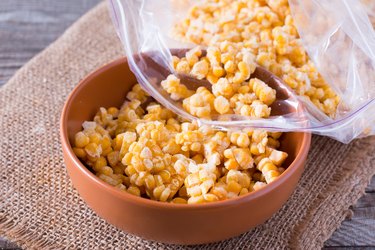
If you've collected too many ears of corn to eat in a reasonable amount of time (and before it loses its sweetness), try freezing it. Freezing corn will help you cut down on food waste and allow you to enjoy the sweet summer veggie year-round.
If you're planning to freeze corn for a later date, don't skip blanching it! The blanching process stops the enzymes from aging the corn, which will lead to bland flavor and an unpleasant color and texture.
Video of the Day
Video of the Day
Tip
Blanching corn in the microwave isn't as precise as other methods. It's possible that the veggie won't be blanched as evenly, which may detract from its flavor, texture or color during the freezing process. If you do have the time and tools, try blanching corn on the stovetop.
How to Blanch Corn in the Microwave
Although corn is safe to eat if frozen without blanching, the National Center for Home Food Preservation recommends blanching vegetables to preserve their flavor and color.
While blanching in boiling water or steam is recommended, you can also blanch corn in the microwave for what may be a more convenient alternative.
Here's how to do it:
- Husk the corn and snap off any excess cob at the base of the ear. Wipe down the outside of the ear of corn with a soft cloth to remove any remaining silk. Rinse the ear under cold water and pat dry.
- Microwave the corn ears on high for 7 to 11 minutes, depending on their size. Turn the corn halfway through the cooking time.
- Fill a large bowl halfway with ice water. Add a tray of ice cubes to the water.
- Drain the corn and plunge the ears into the bowl of ice water. This cools the corn quickly and stops the cooking process. Keep the corn in ice water until the entire ear, including the cob, feels cool. As a rule, blanched vegetables require the same amount of time to cool as they do to blanch — so if you cook the corn for 7 minutes in the microwave, you'll want to blanch it for 7 minutes, too.
- Optional: Once the corn is blanched, try cutting the kernels off the cob — this will give you more space in the freezer, and it'll make meal prep a whole lot easier when you're ready to cook the corn.
- Remove the corn and pack in zippered freezer bags, leaving 1/2-inch headspace. Squeeze out the excess air in the bag and freeze immediately.
Warning
Be careful when removing corn from the microwave as the escaping steam can burn your skin.
How to Freeze Corn
Freezing Whole Kernel Corn
To prepare whole kernel corn, do the following:
- Stand the blanched and cooled ear on its end and slice down the ear, at about 2/3 the depth of the kernels.
- Fill a zippered freezer bag or another freezer container with the kernels and freeze immediately.
Freezing Creamed Corn
You can freeze homemade creamed corn in two ways:
Option 1: For creamed corn, cut the entire kernel from the ear with a sharp knife, scraping the milky juice from the cob with the back of the knife. Seal the creamed corn in freezer containers and freeze immediately.
Option 2: Alternatively, you can make creamed corn by cutting the kernels from fresh corn and cooking in a double boiler for 10 minutes. Cool the creamed corn by placing the pan in a bowl of cool water. Pack in freezer bags or containers, leaving 1/2-inch headroom and freeze immediately.
Tip
One of the best ways to prevent bacteria from invading your food is to keep your appliances at the proper temperature. For the fridge, make sure the temp is set at or below 40 degrees Fahrenheit. The freezer temperature should be set to zero degrees Fahrenheit, according to the FDA.
Frozen Corn Recipes
Once your corn is properly frozen, you'll have up to a year to dream up the many ways you can cook sweet corn. Here are a few recipes to get you started: